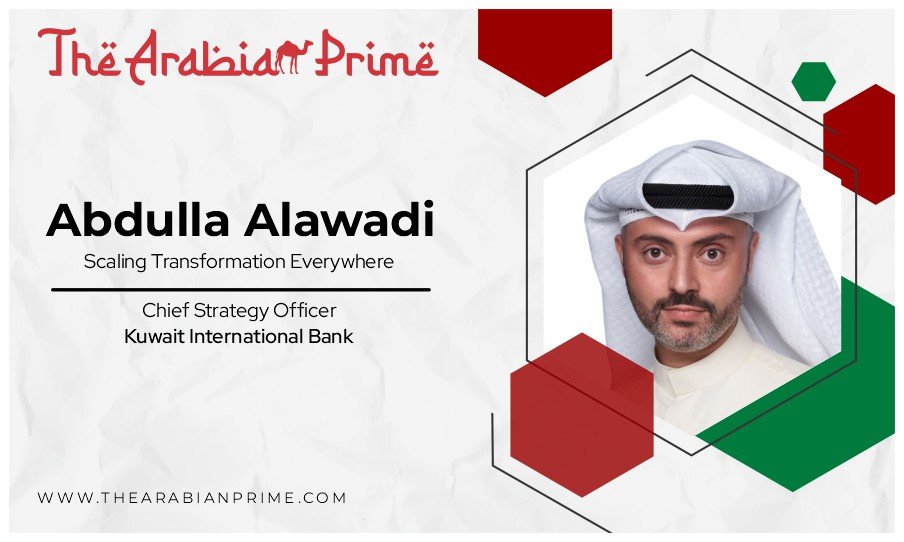Top Most Dynamic and Influential Business Leaders to Watch in 2025

Leveraging experience and AI technology to help organizations implement strategy, manage projects, and navigate change effectively!
Change can feel like stepping into the unknown, yet for some, it is a space full of opportunity. Abdulla Alawadi thrives in that space. Every day, he works on turning ambitious ideas into practical realities. As Chief Strategy Officer at Kuwait International Bank, he guides strategy, projects, and processes, while ensuring teams move forward together.
For Abdulla, strategy begins with clarity and purpose. Each plan connects to a larger vision, and every project builds on the previous one. Alongside refining processes and improving efficiency, he focuses on helping people embrace the journey. Transformation succeeds when individuals feel supported and equipped to contribute to the change.
His approach follows a clear sequence: develop a strategy, implement it project by project, and guide the people affected along the way. Achieving this requires tools, frameworks, and experience to bring structure to complex challenges. Abdulla has spent years gathering this knowledge and now channels it into Essam.ai, an AI-powered platform that empowers organizations to manage change effectively and sustainably.
Through Essam.ai, Abdulla extends his expertise beyond one organization. He creates a system where transformation can scale, helping businesses everywhere move with confidence and purpose. His work highlights that change is a journey to be navigated thoughtfully, with every decision, every project, and every person playing an essential role in shaping the future.
The Spark Behind ESSAM.AI
In his role overseeing Change Management, Abdulla focuses on continuous process improvement. Achieving transformation at the desired pace requires establishing baselines, analysing, and optimizing dozens or even hundreds of processes. Hiring additional Lean Six Sigma Black Belts proved challenging and expensive. He explored external solution providers through the procurement team, but the options available met only a fraction of his requirements and came at a high cost. This led him to take matters into his own hands and create his own solution; Essam.ai
ESSAM.AI emerged from this need. The name ESSAM represents a framework that Abdulla designed to address wasteful activities in processes once they are identified. It stands for Eliminate, Simplify, Standardize, Automate, or Migrate these activities elsewhere. He then assembled a talented AI team and began developing the first minimum viable product, transforming the idea into a fully AI-driven process engineering tool.
Reimagining Process Improvement
Abdulla observed that most mainstream process improvement tools remain manual, making them time-consuming and limited. He envisioned ESSAM.AI as a solution that could automatically gather process elements, establish a baseline for current processes, analyse them, and optimize them efficiently. The platform also provides before-and-after process statistics, a ready standard operating procedure, and a concise pitch deck to present the work. This approach aims to democratize process improvement, placing powerful tools in the hands of individuals who are not process experts.
He emphasizes that process improvement carries immense significance for the successful implementation of any transformation. Ambitious plans often require cultural shifts, which depend on changes in how people work and behave. Optimizing business processes facilitates this change, making transformation achievable. Abdulla advises ESSAM.AI users to enhance their operations progressively, focusing on one process at a time.
Moments That Shaped ESSAM.AI
During the early development phases, Abdulla focused intensely on creating the process optimization capability of ESSAM.AI. As the team refined this aspect, he recognized that the platform extended far beyond a simple process improvement tool. It represented a comprehensive business transformation solution. He began developing ESSAM’s feature backlog and quickly grasped the wide scope of its applications.
The platform gathers process elements, establishes a baseline, analyses them, and then optimizes processes through targeted changes. A bespoke tool measures the impact of these changes. When the change registers as moderate or high, ESSAM performs failure mode analysis and planning to manage anticipated risks effectively. It identifies the key individuals who will lead the transformation, evaluates whether their roles are balanced, and recommends necessary adjustments. An ADKAR blueprint is then created to manage the people’s side of change for stronger results.
As implementation proceeds, the platform measures the likelihood of success using monitoring tools such as DICE. If uncertainty arises regarding which processes require change, internal assessment tools guide the identification of areas with improvement potential. Through these capabilities, ESSAM.AI establishes itself as a true business transformation platform.
Amplifying Efficiency Through Lean Principles
ESSAM.AI was designed to multiply the output of a team of Lean Six Sigma Black Belts by ten, enhancing their capabilities rather than replacing them. Abdulla approaches process improvement with a deep understanding of the distinction between process consistency, emphasized by Six Sigma, and Lean, which focuses on improving efficiency by eliminating wasteful activities.
ESSAM identifies these wasteful activities, as outlined in Lean Thinking, and recommends actions to address them: Eliminate, Simplify, Standardize, Automate, or Migrate. By pursuing this continuous effort to remove waste, companies increase their ability to deliver consistent and greater value to customers.
Mastering the Inverse Prompt Approach
ESSAM applies a reverse prompt approach, requesting specific information in a defined sequence, which is hard-coded into the system. This design enables a more focused use of the platform while reducing the possibility of AI hallucinations.
Some challenges arose when users attempted to inquire about unrelated issues, but this represents a deliberate trade-off. ESSAM guides users to transform their business one process at a time through a structured and carefully guided methodology.
Democratizing Process Engineering for All
Continuous process improvement holds immense importance for effective strategy execution, yet many organizations do not have a dedicated team or assigned individual for this responsibility. In numerous large corporations, some teams manage policies and procedures, but no one is specifically tasked with overseeing continuous process improvement.
A professional in this field recognizes that organizations exist to deliver value to customers, and achieving this requires the elimination of wasteful activities from value streams. The scarcity of process experts contributes to this challenge. ESSAM.AI allows non-experts to perform these critical functions, transforming businesses one process at a time. This capability makes it truly revolutionary in its approach.
Transforming Operational Excellence with ESSAM.AI
Abdulla believes that as ESSAM.AI continues to expand its features, it will become an essential tool for organizations undertaking business transformation.
The platform will address areas such as process improvement, risk management, change management, project management, and strategy. Bringing all these capabilities together in a single AI-powered platform creates a powerful resource for organizations striving to enhance operational excellence.
ESSAM.AI as a Catalyst for Business Transformation
When one logs into ESSAM.AI, the platform immediately asks which process requires optimization today. If the user expresses uncertainty about a specific process, ESSAM.AI suggests assessing the current business strategy to identify areas for improvement. It proceeds to ask targeted questions through a bespoke analytical tool in the background and then identifies two to four processes suitable for mapping.
ESSAM.AI continues by baselining, analysing, and optimizing a related process. Upon determining that the proposed new process introduces a moderate degree of change, the platform recommends performing a failure mode analysis to prepare for anticipated risks. It then focuses on a critical role in the change plan, asking a series of questions and assessing whether that individual has a balanced workload using a specialized tool. If adjustments are necessary, ESSAM.AI specifies corrective measures and generates an ADKAR change blueprint for the individual to increase the likelihood of successful implementation.
During implementation, users can return to ESSAM.AI for progress assessment. The platform asks a few questions and provides a gauge to indicate whether the project remains on course, faces risk, or experiences mild derailment. This structured, step-by-step approach exemplifies Abdulla’s vision for ESSAM.AI as a transformative platform, extending far beyond the capabilities of a conventional tool.
Balancing Sophistication with Simplicity
ESSAM.AI offers a chat-based user experience similar to other AI tools. The platform was created with non-technical users in mind, ensuring that anyone with a browser can achieve meaningful optimization results. One of the core design principles of ESSAM.AI is simplicity.
The team behind the platform consistently focuses on maintaining an intuitive and accessible interface, delivered within a guided, well-structured, and sequenced format that makes complex processes approachable for all users.
Enduring Value of Human Intuition in AI-Driven Transformation
Human intuition and creativity continue to play a central role in process transformation, even when AI like ESSAM.AI manages the analytical workload. ESSAM.AI serves as a super team member, supporting users rather than replacing them. Users review the output to ensure accuracy and relevance.
In one instance, while mapping a process, ESSAM identified a step as non-value adding. Abdulla intervened, explaining that the step delivers the value the customer expects. ESSAM acknowledged the insight and updated the process accordingly. Humans leveraging AI produce high-quality work rapidly, but it remains essential to read and verify the AI’s output before finalizing decisions.
Vision for Transforming Enterprise Efficiency
Abdulla envisions ESSAM.AI evolving into the leading business transformation platform powered by AI. He emphasizes the careful selection of specific tools and their strategic application in a defined sequence.
This methodology will serve as the core expertise that distinguishes ESSAM from other platforms, positioning it as a unique solution for enhancing enterprise efficiency and decision-making.
Embracing AI as a Competitive Edge
Building ESSAM.AI has shaped Abdulla’s perspective on innovation, leadership, and the evolving relationship between humans and intelligent systems. Humans will always remain essential. AI will not take over. However, individuals who effectively use AI will surpass those who do not.
Abdulla compares it to arriving at a Formula 1 race with a horse. AI is already present, and baseline expectations assume its role, making it crucial for everyone to elevate their approach. For those seeking to transform their businesses, Abdulla encourages exploring the platform at www.essam.ai.




